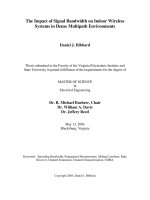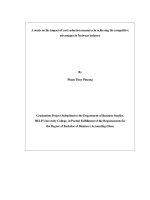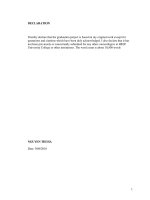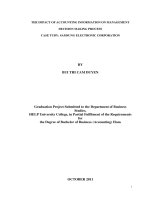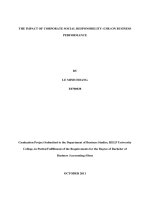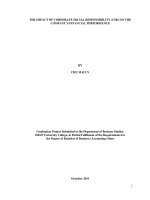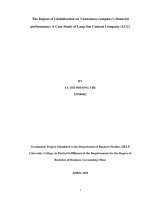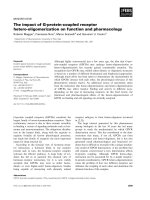The impact of audit quality on cash incentive compensation and cost of capital
Bạn đang xem bản rút gọn của tài liệu. Xem và tải ngay bản đầy đủ của tài liệu tại đây (482.44 KB, 118 trang )
Abstract
I use the agency theory framework to model the effect of audit quality on prin-
cipal agent dynamics. The model shows that as audit quality increases, the weight
placed on accounting earnings in determining managers compensation increases. I
also show that the returns expected by the investors decline with increasing au-
dit quality. Hence the cost of capital to the firm decreases with increasing audit
quality. I find empirical evidence to support the two propositions. The empirical
results confirm that the weight placed on accounting earnings in determining the
incentive pay of both CEOs and non-CEO managers increase with audit quality.
The evidence also confirms that cost of capital of firms declines as audit quality
increases although this effect is only observed in small firms. I further test the
impact of audit tenure and auditor opinion on cost of capital and find that cost
of capital is inversely proportional to auditor tenure, and that cost of capital for
the client will increase if the auditor issues any opinion other than an unqualified
opinion.UMI Number: 3295518
3295518
2008
Copyright 2007 by
Fernando, Guy D.
UMI Microform
Copyright
All rights reserved. This microform edition is protected against
unauthorized copying under Title 17, United States Code.
ProQuest Information and Learning Company
300 North Zeeb Road
P.O. Box 1346
Ann Arbor, MI 48106-1346
All rights reserved.
by ProQuest Information and Learning Company.
Copyright 2007 Guy D. Fernando
All rights reserved.
1 Overview 1
1.1 Introduction . . . . . . . . . . . . . . . . . . . . . . . . . . . . . . . 1
1.2 Literature Review . . . . . . . . . . . . . . . . . . . . . . . . . . . . 5
1.2.1 Compensation . . . . . . . . . . . . . . . . . . . . . . . . . . 5
1.2.2 Cost of Capital . . . . . . . . . . . . . . . . . . . . . . . . . 10
1.2.3 Audit Quality . . . . . . . . . . . . . . . . . . . . . . . . . . 12
1.2.4 Other audit and auditor attributes that impact Cost of Capital 16
1.2.5 Summary . . . . . . . . . . . . . . . . . . . . . . . . . . . . 20
2 Analytical model - Effect of Audit quality on Incentive Compen-
sation and Cost of Capital 21
2.1 Model . . . . . . . . . . . . . . . . . . . . . . . . . . . . . . . . . . 21
2.2 Results . . . . . . . . . . . . . . . . . . . . . . . . . . . . . . . . . . 22
3 Empirical Study 1 - Effect of Audit Quality on Incentive Com-
pensation 27
3.1 Hypothesis development . . . . . . . . . . . . . . . . . . . . . . . . 27
3.2 Data and Research Design . . . . . . . . . . . . . . . . . . . . . . . 28
3.2.1 Data . . . . . . . . . . . . . . . . . . . . . . . . . . . . . . . 28
3.2.2 Research Design . . . . . . . . . . . . . . . . . . . . . . . . . 28
3.3 Results and Analysis . . . . . . . . . . . . . . . . . . . . . . . . . . 34
3.3.1 Descriptive Statistics . . . . . . . . . . . . . . . . . . . . . . 34
3.3.2 Control Variables . . . . . . . . . . . . . . . . . . . . . . . . 36
3.3.3 Specialist auditors . . . . . . . . . . . . . . . . . . . . . . . 37
3.3.4 BigX auditors . . . . . . . . . . . . . . . . . . . . . . . . . . 39
3.3.5 Analysis with both Specialist and BigX variables . . . . . . 40
3.3.6 Audit quality and non-CEO Executive compensation . . . . 41
v
3.3.7 Sensitivity Analysis . . . . . . . . . . . . . . . . . . . . . . . 42
3.3.8 Fixed Effects Regression . . . . . . . . . . . . . . . . . . . . 43
3.4 Alternative Explanations . . . . . . . . . . . . . . . . . . . . . . . . 44
3.4.1 Governance . . . . . . . . . . . . . . . . . . . . . . . . . . . 44
3.4.2 Earnings Quality . . . . . . . . . . . . . . . . . . . . . . . . 46
3.5 Summary and Discussion . . . . . . . . . . . . . . . . . . . . . . . . 48
4 Empirical study 2 - E ffect of Audit Quality on Cost of Capital 49
4.1 Hypothesis development . . . . . . . . . . . . . . . . . . . . . . . . 49
4.2 Data and Research Design. . . . . . . . . . . . . . . . . . . . . . . . 50
4.2.1 Large Firms and Small Firms . . . . . . . . . . . . . . . . . 51
4.2.2 Specialization . . . . . . . . . . . . . . . . . . . . . . . . . . 51
4.2.3 Cost of Capital - r
e
. . . . . . . . . . . . . . . . . . . . . . . 52
4.2.4 Regression Models . . . . . . . . . . . . . . . . . . . . . . . 53
4.3 Empirical Results . . . . . . . . . . . . . . . . . . . . . . . . . . . . 55
4.4 Robustness checks . . . . . . . . . . . . . . . . . . . . . . . . . . . . 61
4.5 Summary and Discussion . . . . . . . . . . . . . . . . . . . . . . . . 64
5 Conclusions 68
6 References 70
7 Appendix A - Detailed model derivation 78
8 Appendix B - Computation of the Economic Impact of Auditor
Specialisation on Compensation 83
9 Appendix C - Data Definitions for tables 1 - 11 87
10 Appendix D - Data Definitions for tables 12 - 17 88
vi
List of Appendices
Appendix A - Detailed model derivation 78
Appendix B - Economic Impact of Auditor Specialisation on
Compensation 83
Appendix C - Data Definitions for tables 1 - 11 87
Appendix D - Data Definitions for tables 12 - 17 88
vii
List of Tables
Table 1-Descriptive Statistics 89
Table 2 - Correlation Coefficients 90
Table 3 - Regression of CEO compensation against Control variables.
Full sample of clients 91
Table 4 - Regression of CEO compensation against audit quality.
BigX clients only 92
Table 5 - Regression of CEO compensation against audit quality.
Full sample of clients 93
Table 6 - Regression of CEO compensation against audit quality.
Full sample of clients 94
Table 7 - Regression of non-CEO Executive compensation against
audit quality. BigX c lients only 95
Table 8 - Regression of Change in CEO compensation against
audit quality. BigX c lients only 96
Table 9 - Regression of CEO compensation against audit quality.
Fixed Effects model. BigX clients only 97
Table 10 - Regression of Change in CEO compensation against
audit quality. Fixed E ffects model. BigX clients only. 98
Table 11 - Regression of CEO compensation against audit quality after
controlling for Governance and Earnings Quality. BigX clients only 99
Table 12 - Breakdown of the dataset 100
Table 13 - Descriptive statistics 101
Table 14 - Correlation Coefficients 103
Table 15 - Cost of Capital regressed against BigX. Full sample 104
Table 16 - Cost of Capital regressed against SPX. BigX clients only 105
Table 17 - Cost of Capital regressed against both BigX and SPX 106
viii
Acknowledgements
I would like to express my deepest gratitude to my advisor and mentor, Professor
Alex Thevaranjan. His guidance and support contributed immeasurably to my
career at Syracuse University. My thanks also go out to the rest of my committee,
Professors Bill Brown, Hsihui Chang, Randy Elder and David Richardson.
I acknowledge the funding I received from Syracuse University over the last
four years, which enabled me to continue with my studies without having to worry
about finances.
I would also like to express my appreciation to the rest of the faculty in my
department, both past and present; notably Professors Mo Onsi, Badr Ismail,
David Harris and Anver Ahmed.
My time as a PhD student at Syracuse University was made a lot easier by my
fellow PhD students. My thanks go out to all of them, especially Scott Duellman
and Ahmed Abdel-Meguid.
I gratefully acknowledge my wife Jasmine who stood by me during these four
years, and our daughter Jayathri who appeared during the middle of this period
and turned my life upside down. Thank you Amma (mother) Thaththa (father)
and Nangi (sister) for your support and encouragement throughout my life. Special
thanks also go out to my mother-in-law who came over to help us during the most
hectic phase of my PhD.
Finally I thank all of you who had faith in me. I will do my best to fulfill your
expectations.
ix
1 Overview
1.1 Introduction
Research has established that higher quality auditors receive a fee premium. Re-
search also shows how higher quality auditors impact various firm parameters such
as earnings quality, earnings response coeffic ients etc. However, the effects of audit
quality on the agency aspects of a firm have not been s tudied in detail even though
auditing has been identified as one of the main ways in which the agency problem
of a firm c an be mitigated. Accordingly, in this paper I investigate the effect that
audit quality would have on managerial incentives and cost of capital of the firm.
Motivating an agent to take actions in the best interest of the principal is
an important area of research in several academic disciplines including finance,
accounting, economics, management etc. It is widely accepted that performance
linked compensation is the most effective way of obtaining such congruence, when
the managerial effort is unobservable by the principal (Jensen and Meckling 1976;
Murphy 1999). Accounting measures of performance, most notably earnings are
widely used in compensation contracts to link pay to performance (Lambert 1993).
But accounting earnings can be easily manipulated by the management (De-
chow et al. 1995). In fact Healy (1985) finds that managers engage in earnings
management sp ec ifically to impact their incentive payments. However, if there is
an external auditor, who can assure the quality of earnings, the principal will have
more faith in earnings and place greater weightage in that measure in designing
the managers’ compensation contract. Prior research shows that specialist audi-
tors perform a higher quality audit
1
than non specialist auditors (Krishnan 2003;
1
DeAngelo (1981) defines audit quality as ”‘the ability to detect and the willingness to re-
port breaches in the clients accounting system.” Hence, audit quality becomes a function of the
technical expertise of the auditor, which will e nable him to detect ’breaches’ and the auditors
political power vis-a-vis the managers of the firm that will enable him to report the ’breaches’
to the shareholders.
1
Balsam et al. 2003). It also shows that higher quality auditors ensure a lower
level of earnings management resulting in higher quality earnings (Becker et al.
1998). According to agency theory the improvement in earnings quality makes the
earnings measure more attractive for contracting purposes. Hence, I argue that
specialist auditors will cause the principal to place a greater weight on earnings in
determining the managers’ compensation compared to non-specialist auditors.
I also investigate the effect of the two audit quality attributes, size and industry
specialization, on the cost of capital of client firms. Specifically, I examine which
roles of auditing affect the cost of capital of the client firm. The four largest audi-
tors dominate today’s auditing market. In such a setting, auditing firms will rely
on quality differentiating strategies that enable them to expand and/or maintain
their client base. One of these strategies is industry s pecialization. Thus my study
goes beyond the traditional BigX -non-BigX size dichotomy quality differentiation,
to the more timely iss ue of quality differentials among the BigX group.
2
The auditor provides ”reasonable assurance” that the financial statements are
free from ”material misstatements”. Auditing dilutes the adverse effects of the
separation of ownership and control (Jensen and Meckling 1976). Thus auditing
is a means of reducing information risk for users of financial statements. This
risk reduction should be matched by a reduction in the cost of capital for the
firm (Lambert et al. 2006). The demand for auditing in capital markets could be
analyzed from three different perspectives (i.e. auditing roles); a monitoring role,
2
BigX firms refer to the large public accounting firms that perform most of the audits for
publicly traded firms. The BigX were called the Big8 audit firms in the 1970s and the 1980s.
The Big8 consisted of Arthur Andersen, Arthur Young, Coopers & Lybrand, Ernst & Whinney,
Deloitte, Haskins & Sells, Peat Marwick International, Price Waterhouse & Touche Ross. In
1989, Ernst and Whinney merged with Arthur Young to become Ernst and Young and Deloitte,
Haskins & Sells me rged with Touche Ross to become Deloitte & Touche. From 1989, the BigX
were referred to as the Big6. Price Waterhouse merged with Coopers & Lybrand in 1998 to
become PricewaterhouseCoopers and the Big6 became the Big5. Arthur Andersen collapsed
after the firm’s indictment for obstruction of justice involving Enron in 2002, and the Big5
became the Big4. Peat Marwick International became KPMG. Hence the Big4 now consists of
PricewaterhouseCoopers, KPMG, Ernst & Young and Deloitte & Touche.
2
an information role and an ins urance role (Wallace 1980). How the auditor fulfills
these roles determines the level of audit quality.
DeAngelo (1981) posits that the BigX auditors provide better audit quality
than non-BigX firms. Audit quality is defined as the joint probability that the
auditor will (1) detect ”breaches” in the client’s accounting system, and (2) will
report them. It is widely accepted in the literature that Big X auditors provide,
or are perceived to provide, higher levels of audit quality (e.g., Teoh and Wong
1993, Becker et al. 1998, Francis et al. 1999). After a series of mergers among
the Big X and the recent collapse of Andersen, the Big 4 audit the majority of
publicly traded companies in the US. Thus an interesting and relevant question to
be addressed is whether there are quality differentials among the BigX in terms of
the effectiveness of performing the three roles discussed above.
Khurana and Raman (2004) (hereafter KR) show that clients of BigX auditors
have significantly lower cost of capital compared to clients of non-BigX auditors
in the US but not in other Anglo-American countries. They argue that the per-
ception of BigX performing higher quality audits than non-BigX is a function of
the litigation environment. Their conclusion is that the threat of litigation is a
stronger driver than reputation behind perceived audit quality, proxied by cost of
capital. This conclusion implies that the investing public primarily perceives audit
quality in terms of the BigX auditor’s ”deep pockets”. Thus their paper primarily
studies the firm size audit quality attribute from an insurance role perspective.
This role is magnified in a more litigious environment like the US, but may be of
less importance to investors in other environments (i.e. UK, Australia or Canada).
The main purpose of the multi-country analysis used by KR was to examine
how litigation environments moderate the effect of auditor size on perceived audit
quality. KR analyze audit quality from a litigation exposure versus reputation
perspective. I extend their work and attempt to disentangle insurance from non-
3
insurance roles of auditing. I argue that the monitoring and information roles of
auditing are related to the technical aspects of auditing. These technical aspects
correspond to both the auditor’s competence and independence as described by
DeAngelo (1981). On the other hand the insurance role is related to the compen-
satory aspects of the audit. Thus the latter role is merely a function of the level
of financial endowments of the auditor regardless of its technical qualities.
I further analyze the type of firms that may b enefit from having a higher quality
audit. The effect of firm size in the available information environment of the firm
is well documented (e.g., Atiase 1985; Bamber 1987; Llorente et al. 2002). These
papers show that larger firms have a better information environment compared
to smaller firms. Hence, the incremental value of audit quality will be greater for
small clients than for large clients. I analyze the KR results to examine whether
client size plays a role in the effect of audit quality on cost of capital.
By holding the litigation environment constant, any differences in the level of
perceived audit quality (i.e. cost of capital) is likely to be a function of the mon-
itoring and information roles rather than the insurance role. Therefore I select
an audit quality attribute that only relates to the first two non-insurance roles,
namely industry specialization. Industry sp e cialization refers to industry-specific
knowledge and expertise an auditor gains from extensive auditing in any one indus-
try. Empirical evidence shows that industry specialization is an important audit
quality attribute that varies among Big X auditors (Balsam et al. 2003; Krishnan
2003; Francis et al. 2005).
I find that small firms in the sample drive the results shown in KR. Lower cost
of capital associated with clients of BigX auditors is limited only to small clients.
Furthermore, the results confirm that the ex − ante cost of capital is lower for
small clients who engage specialist BigX auditors compared to clients who engage
non specialist BigX auditors.
4
I further examine the impact of different attributes of the auditor and the audit
on the cost of capital of the client firm. I find that the cost of capital is inversely
proportional to the length of the auditor tenure. I also find that the client firms
cost of capital increases if the auditor issues any opinion other than an unqualified
opinion. Again these results are driven by the smaller firms.
This study contributes to the literature in the following ways. First, I show that
the weight placed on accounting earnings in determining executive cash compen-
sation increases with audit quality. Next, I show that audit quality lowers the cost
of capital for small clients. Finally, I examine the effect of industry specialization
as an audit quality attribute in two new settings, namely executive compensation
and the cost of capital.
The paper is structured as follows. The remainder of Chapter 1 will contain
the literature survey. Chapter 2 describes the analytical model. Chapter 3 consists
of the empirical analysis of compensation and audit quality, including the data,
empirical results, sensitivity analysis and a discussion of the results. Chapter 4
contains the empirical analysis of cost of capital and audit quality. Chapter 5
discusses the conclusion.
1.2 Literature Review
1.2.1 Compensation
CEOs
Most of the literature in compensation looks at CEO compensation. Both CEO
compensation and academic rese arch on CEO compensation has grown rapidly
in recent years.
3
The financial press to o is actively looking into the perceived
excesses in CEO compensation.
4
Hence, CEO pay is a matter of utmost interest to
3
Murphy (1999) says that ”CEO pay research has grown even faster than CEO paychecks”.
4
A search on Lexis-Nexis for CEO pay for May 2006 shows 22 hits.
5
academics, practitioners, regulators and the public. I attempt to provide additional
insight to this evolving field of executive compensation.
In the modern business environment, the functions of ownership and manage-
ment are separate. In such circumstances, classic agency theory states that the
owner (principal) can get the manager (agent) to maximize the principal’s utility
through monitoring and incentive alignment (Jensen and Meckling 1976). I inves-
tigate the effect of audit quality on the monitoring aspec t and incentive alignment
aspect of managerial performance.
Theoretical research into agency theory shows that to motivate risk averse
managers into exerting effort so as to maximize the utility to the principal, the
managers’ incentives should be aligned to the performance of the firm. Holm-
strom (1979) shows that when the ultimate outcome alone is observable (and not
managers effort), the optimal contract will be the ’second best contract’, meaning
the contract will be based on the observable outcome. Banker and Datar (1989)
show that different signals of firm performance can be aggregated into an optimal
measure of performance on which to base the compensation contract. Je nsen and
Murphy (1999: p242) summarize the essence of agency theory as ”‘Agency theory
predicts that an optimal contract will tie the manager’s expected utility to prin-
cipal’s wealth; therefore agency theory predicts that CEO compensation policies
will depend on changes in shareholder wealth”’.
There is a long stream of literature that empirically analyzes the sensitivity of
CEO pay to firm performance. Smith and Watts (1982) state that incentive plans
explicitly tie CEO’s performance to changes in firm value. They also state that
cash incentives are tied
ex − ante
to some measure of firm profit. Lambert and
Larcker (1987) analyze a sample of firms from the F orbes annual compensation
survey for the period 1970-1984 and show that profits are strongly related to cash
compensation. Jensen and Murphy (1990) show that CEO compensation is directly
6
proportional to increases in shareholder wealth, and that the pay increases by
$3.50 for every $1000 increase in shareholder wealth. Sloan (1993) investigates the
relative weights placed on earnings and stock returns in CEO cash compensation,
and show that the relative weights depend on the noise of the two signals. More
recently, Core et al. (2003) document the positive relationship between earnings
and CEO pay.
CEO compensation broadly consists of three attributes (Murphy 1999; Conyon
2006). One is the base salary, which is one of two cash based components. The base
salary is generally a fixed amount negotiated by the CEO beforehand. The other
cash component is the bonus, which is generally based on the ex-post performance.
Finally there is a component of equity and long term stock awards. In addition to
the stock options awarded annually, the CEO will also benefit from the increase in
value of his existing equity and options of the firm.
According to Lambert and Larcker (1987) the cash component comprised around
80%-90% of the total CEO compensation in the mid 1980s. However, with the ex-
plosive growth in CEO options, this proportion has been declining. Conyon (2006)
shows that the cash component (base salary + bonus) of CEO compens ation was
52% in 2003. Due to this decline, there is a tendency to ignore the importance
of the cash comp onent in compensation. However, it is important to note that a
significant proportion of compensation is in the form of cash, and there are still
some parts of the puzzle that are not totally understood.
The incentives for cash compensation and equity compensation are different.
Cash compensation is generally linked to past performance. Bonuses are mostly
linked to the prior period’s accounting numbers (Murphy 1999). Hence cash com-
pensation shows a strong positive relationship to accounting numbers (Lambert
and Larcker 1987; Sloan 1993). This indicates that the cash component of com-
pensation is a reward for past performance.
7
On the other hand, much theoretical work hypothesizes that equity compen-
sation is intended to induce risk-averse managers to take risks on behalf of share-
holders (Jensen and Meckling 1976; Copeland et al. 2005 pg 487; Murphy 1999).
Equity compensation will provide incentives for the managers to maximize share-
holder wealth by tying the managers’ compensation directly to increases in the
stock price (Core et al. 2003; Hanlon et al. 2003). Hence, it is apparent that eq-
uity compensation is a method to induce risk taking by the managers. Smith and
Watts (1992) show that firms in industries with greater investment opportunities
will be more likely to use stock options in compensating their CEOs. Rajgopal
and Shevlin (2002) analyze the risk taking behavior of a sample of managers from
the oil and gas industry and show that equity compensation is related to risk tak-
ing. If so, it would mean that equity compensation will not be related to past
accounting performance. Instead, it will be related to future performance of the
firm. Hanlon et al. (2003) show that equity compensation is related to future
earnings, while Baber et al. (1996) and Core et al. (1999) find that there is no re-
lationship between equity compensation and past accounting performance. Hence,
prior research illustrates two distinct and separate motives for cash and equity
compensation.
Lewellen et al. (1987) explicitly states this dichotomy in the composition of
CEO compensation.
”Consider first, the role of immediate forms of compensation - salary and current
bonus
5
- in the pay package. By whatever formula these payments are established, the
payoff to the executive/recipient necessarily reflects only the firms revealed performance
up to the payment date; the amounts involved are fixed when awarded and as received are
independent of the firm’s subsequent performance. Moreover bonus awards are typically
based on short-term performance measures such as current year profits or return on
equity. The time horizon relevant to shareholders however is in principle unlimited since
all future residual cashflows the firm is expected to generate should be impounded in
share prices. Managers therefore may need to be given an explicit claim to those future
cash flows in order to encourage proper attention to decisions that will favorably affect
them.
5
Salary and bonus is the cash component of compensation
8
This can be accomplished either by conveying to managers an equity interest in the
firm through some type of restricted stock compensation or by deferring a portion of
cash compensation.” - Lewellen et al. (1987) pg 289.
This leads me to conclude that since past earnings will be important only in de-
termining cash compensation, e arnings quality will be important to cash c ompen-
sation, but not to equity compensation. Audit quality will impact past accounting
returns. And since I am investigating the effect of audit quality on compensation,
I posit that audit quality will have greater impact on the cash component of CEO
compensation than on the equity component.
Non-CEO Executives
Agency theory posits that the effect predicted for managers would apply to
non-CEO executives as well. However, the non-CEO managers cannot directly
control the accounting profits of a firm, since each may be responsible only for a
single functional or geographical area of performance. On the other hand, when
all non-CEO executives are considered in the aggregate, the common feature of
their performance will be the impact on firm profitability. Therefore, the question
arises whether it is fair to let the overall firm performance (calculated in terms of
ROA or ROE) impact the compensation of non-CEO executives?
There has been relatively little research on non-CE O executive compensation,
with most of it appearing in management literature. When it comes to deter-
mining the compensation of non-CEO executives, Balkin and Gomez-Mejia (1990)
find that in a study of compensation of business units within firms, corporate
profitability is linked to the pay levels. Fisher and Govindarajan (1992) analyze
the compensation of profit center managers and find that Return on Equity of the
firm is significantly and positively related to the compensation level of profit center
managers.
Lambert et al. (1993) conduct a study on the compensation of 4 distinct
organizational levels (ranging from plant manager to CEO) on a sample of 303
9
publicly traded firms during the years 1982 - 1984. They use the overall firm ROA
as a control variable in the analysis and find that ROA is positive and significant.
More recently, Carpenter and Wade (2002) find that prior ROA is also significantly
related to the compensation level of non-CEO e xecutives.
Several studies derive their hyp othesis for executive compensation using agency
theory, and assume that firm profitability is a component of executive compensa-
tion. But the studies do not limit the executive to CEOs. Antle and Smith (1986)
use the 3 most highly paid executives of the firms in their sample. Lewellen and
Huntsman (1970) derive their hypothesis that the executives’ pay is related in a
linear fashion to both profits and sales of the firm without making any distinction
between CEOs and non-CEO executives. Although they only use the single highest
paid executive’s pay for each firm, they explain this by stating
”‘ As a matter of both convenience and efficiency, the compensation of the single
highest paid executive in each firm in each year is taken into account here as the dep en-
dent variable measuring the size of the firm’s managerial pay package. While it may seem
more appropriate that the remuneration of all the senior policy-making individuals in a
corporation be tested for a relationship to company performance, it happens that the
pay of a firm’s top man is a suitable surrogate for the pay of his closest subordinates in
terms of their relative standing vis-a-vis corresponding officials in other firms. - Lewellen
and Huntsman (1970), pg 714”’
The above review shows that even non-CEO executive compensation is affected
by the overall firm performance. In this study, I attempt to answer the question;
if the quality of the performance measure improves (as will accounting measures
in the face of better quality audit), will there be a greater weight placed on that
performance measure in determining the compensation of non-CEO executives as
well?
1.2.2 Cost of Capital
Cost of capital to the firm is the return expected by the investors when they invest
money in the firm (Lambert et al. 2006). The rational investor will expect a return
10
in accordance with the CAPM model, that will cover the risk free return he could
obtain by investing in risk free securities and a risk premium for investing in the
risky assets of a firm. A firm’s risk is a function of external forces (GDP growth,
inflation, political situation etc) as well as internal forces (managerial performance,
agency problems etc).
The separation of ownership and control of the firm leads to information asym-
metries between the owners and manager of the firm (Jensen and Meckling 1976).
In addition rational expectation theory and agency theory suggest that the prin-
cipals (investors) and agents (managers) would have divergent interests resulting
in a moral hazard problem. Wallace (1980) argues that investors price-protect
their investments resulting in a reduced stock price, which implies a higher cost of
capital.
As information asymmetries are reduced via more transparent and reliable in-
formation, the risk assumed by investors should decline. This would ultimately lead
to less price protection. Barry and Brown (1985) suggest that better information
can reduce the rate of return demanded by the investors by reducing estimation
risk. Merton (1987) suggests that better information reduces cost of capital by
improving risk sharing. Lambert et al. (2006) state that better information will
lead to lower cost of capital due to better alignment between the firm’s investment
opportunities and its investment choices. Easely and O’Hara (2004) show in their
analytical paper that investors will demand higher returns (and hence increase the
cost of capital) from firms which have lower public information compared to the
private information available.
Several empirical studies have reinforced the analytical work mentioned above.
Botosan (1997) show that the level of disclosure provided in the annual reports of
a sample of 122 manufacturing firms in 1990 is negatively related to cost of capital.
This result is confirmed in Botosan and Plumlee (2002). Francis et al. (2004) find
11
that firms with better quality earnings enjoy a lower cost of capital.
Standard setters have stressed the connection between improved information
quality and reduced cost of capital. Arthur Levitt (1998), the former chair of
the Securities and Exchange Commission stated that ”high quality accounting
standards [ ] reduce capital costs.” More recently, John M. Foster (2003), a former
member of the FASB mentions in the FASB report that
” Numerous academic studies have concluded that more information in the mar-
ketplace lowers the cost of capital. Upon reflection, although it is nice to have empirical
support, academic studies are not really necessary to reach this conclusion; it is intu-
itive. More information always equates to less uncertainty, and it is clear that people pay
more for certainty. Less uncertainty results in less risk and a consequent lower premium
being demanded. In the context of financial information, the end result is that better
disclosure results in a lower cos t of capital.”
Hence, since higher inf ormation levels lead to lower cost of capital, I investigate
the impact of audit quality in improving the information environment, and thus
lowering the cost of capital for firms.
1.2.3 Audit Quality
The auditor provides ”reasonable assurance” that the financial statements are
free from ”material misstatements”. Auditing, to a certain extent, mitigates the
agency problems arising out of the separation of ownership and control (Jensen and
Meckling 1976). Wallace (1980) describes three main roles of auditing, namely the
monitoring role, the information role and the insurance role.
The Monitoring Role of Auditing and Cost of Capital
The monitoring role for auditing implies that auditing will ensure better use
of resources e ntrusted to the agent by the principal. Jensen and Meckling (1976)
state that one component of the agency cost is the cost of monitoring the man-
agers. Chow (1982), in a study of firms publicly traded in 1926
6
, found that the
6
The use of a sample from 1926 controls for the mandatory engagement of an auditor that
was later required by the 1933 and 1934 Securities acts.
12
probability of engaging an auditor is increasing in the degree of conflict among
the stakeholders of the company. In addition, Francis and Wilson (1988) show
that the demand for quality differentiated audits, proxied by auditing firm size is
positively related to the company’s agency costs. Thus I posit that the monitoring
role of the audit is effec tive in mitigating the agency problem arising out of the
separation of ownership and control of the firm. The e ffectiveness of the auditor
as monitor on behalf of the owners will be reflected in the risk premium demanded
of the firm by the owners, and will lead to a lower cost of capital. I also posit that
this monitoring effect will manifest itself in the CEO compensation awarded by
the firm.
The Information Role of Auditing and Cost of Capital
As previously mentioned, one of the adverse effects of the separation of owner-
ship and control is information asymmetries between managers and investors. As
information asymmetries are reduced via more transparent and reliable informa-
tion, the risk assumed by investors should decline. This would ultimately lead to
less price protection. Barry and Brown (1985) suggest that better information can
reduce the rate of return demanded by the investors as it reduces estimation risk.
Merton (1987) finds that better information reduces cost of capital by improving
risk sharing. Lambert et al. (2006) state that better information will lead to lower
cost of capital due to better alignment between the firm’s investment opportuni-
ties and its investment choices. Principal agent theory states that if investors had
perfect information about the managers and the states of the world, an enforceable
contract can be implemented. However, in environments of imperfect information,
the level of information will be tied to incentives based on observable performance
measures. The better the quality of the performance measure, the greater the
weight placed on the performance measure.
The Insurance Role of Auditing and Cost of Capital
13
The insurance role postulates that risk to the investors will be reduced because
the investors will have another source of compensation, namely the auditor, in the
event of failure of the firm. Menon and Williams (1994) argue that this insurance
factor is built into the share price of the client firm. They examined the impact of
the bankruptcy of Laventhol & Horwath (L&H) on the stock prices of its clients.
They document a significant negative effect on the stock prices and attribute this
to the deterioration of the insurance capacity of L&H. Within the context of cost
of capital, KR document a significant negative relation between engaging a B ig4
auditor and the cost of capital of the client. This negative relation was only found
in the US but not in other Anglo-American countries. They attribute this finding
to the differences in litigation exposure between the US and the other countries.
While this role does not have much bearing on managers’ compensation, it has
a significant bearing on the cost of capital of a firm. The first two roles of the audit
indicate that higher audit quality will lead to lower cost of capital for the client
firm (technical aspect of auditing). The third role of the audit indicates that the
more financial resources the auditor has, the lower the cost of capital of the client
firm (compensatory aspect of auditing). Based on the above discussion, I argue
that the monitoring and information roles of auditing are ex ante roles. These
roles dilute the negative effects of agency problems on the pricing of stocks. On
the other hand, the insurance role of auditing is an ex − post role, which increases
in importance after some form of failure in highly litigious environments.
Investors consider the deep pockets of auditors as safety nets in case of incur-
ring losses on their investments. The number of audit failures and the associated
lawsuits are small relative to the number of audits of publicly traded companies.
Therefore the insurance role of auditing, although important, should not over-
shadow the importance of the monitoring and information roles of auditing that
directly relate to it technical aspects. Thus I examine how the three roles of au-
14

